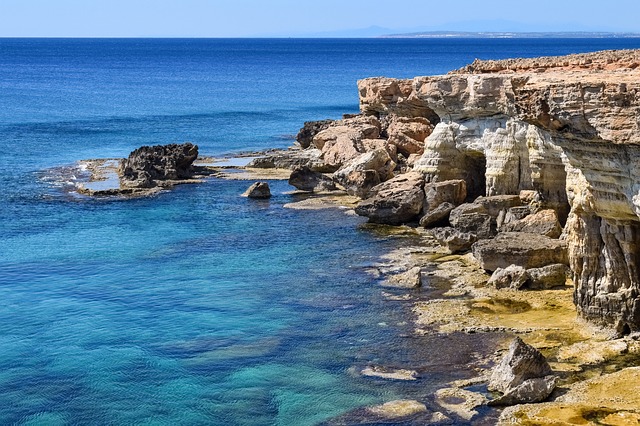By Tim Lambert
Ancient Cyprus
The first people in Cyprus were stone age farmers about 8,000 BC. By 4,000 BC they were making pottery and copper tools. By about 2,500 BC the people of Cyprus had learned to make bronze. The society of Cyprus gradually grew more sophisticated after 1,600 BC a form of writing was invented. A highly civilized society emerged in Cyprus with many towns and palaces. Trade with other parts of the Mediterranean flourished and contact with other civilizations was common.
After 800 BC a series of great empires arose in the Middle East. The first was the Assyrian Empire. The Assyrians never actually conquered Cyprus but they forced its rulers to pay tribute for a short period from c 708 BC to 669 BC. Then in 545 BC, Cyprus was forced to submit to rule by the Persians. The Persians, in turn, were overthrown by the Greeks led by Alexander the Great after 333 BC.
When Alexander died in 323 his empire was split between his generals. One of them called Ptolemy seized Egypt. After a period of fighting, he and his successors came to rule Cyprus and Greek culture became dominant on the island. However, a new power arose – Rome. The Romans took Cyprus in 58 BC and it became integrated into the Roman Empire. n Christianity was introduced into Cyprus by 2 men called Paul and Barnabas about 45 AD.
Then in the 4th century AD, the Roman Empire split into 2 parts, East and West. Cyprus became part of the Eastern Roman Empire. When the Roman Empire in the west fell in 476 AD the Eastern part continued. It is known to us as the Byzantine Empire.
Cyprus in the Middle Ages
Under Byzantine rule, Cyprus prospered despite raids by the Arabs between the 7th century and the 10th century. However, by the 12th century, the Byzantine Empire was declining. In 1184 a Byzantine prince called Comnenus declared Cyprus independent from the rest of the empire. However, independence did not last long. In 1191 Richard I, king of England captured Cyprus. He sold it to a Frenchman named Guy de Lusignan.
The Lusignans ruled Cyprus for 3 centuries. Cyprus became a feudal kingdom where a Catholic elite ruled over the Orthodox majority. However, in the 14th century, the Italian cities of Genoa and Venice were growing increasingly rich and powerful threatening the independence of Cyprus. Then in 1425, the Mamelukes from Egypt raided Cyprus.
Finally, the king of Cyprus married a Venetian woman. The king died leaving the queen sole ruler of Cyprus. In 1489 she was persuaded to abdicate and Cyprus came under direct Venetian rule. However, the Ottoman Turks were now the rising power in the Mediterranean. In 1571 they conquered Cyprus.
CYPRUS 1571-1945
At first, most Cypriots welcomed Turkish rule preferring it to the oppressive Venetian rule. The feudal system was abolished and the Turks respected the Orthodox Church. Nevertheless, plague struck Cyprus at intervals and there were eventually rebellions against Turkish rule.
In the 19th century, Britain became a superpower. In 1875 the Suez Canal opened and Britain was keen to protect the route to India. In 1878 the British were allowed to occupy and administer Cyprus (although Turkey was technically still sovereign).
However, in 1914 the Turks joined Germany’s side in the First World War, and Britain formally annexed Cyprus. In 1925 Cyprus was made a British Crown Colony. n However Greek Orthodox Cypriots now demanded enosis (union with Greece) and in 1931 riots took place.
During the Second World War, many Cypriots fought for the British. However, when peace came Greek Orthodox Cypriots again demanded union with Greece. Turkish Cypriots, on the other hand, wanted British rule to continue.
Cyprus in the late 20th Century
In 1955 a Greek Cypriot organization called EOKA began a series of bombings in Cyprus. In 1958 a Turkish organization called TMT was formed and inter-communal fighting began. Finally, in 1960, Cyprus was granted independence. Archbishop Makarios was elected president.
However, in 1963, the Greeks proposed changes to the constitution. The Turks refused and there was more inter-communal fighting. In 1964 the UN sent a peacekeeping force to Cyprus. However, a solution was not found and in 1974 hard-line Greeks staged a coup. Archbishop Makarios was overthrown and fled abroad.
As a result, in July 1974 Turkish forces invaded Northern Cyprus. The island became partitioned. Refugees from both sides crossed the border between the two parts of Cyprus. Meanwhile, the hardliners fell from power and in December 1974 Archbishop Makarios returned from exile. He died in 1977.
In 1975 the Turkish section called itself the Turkish Federated State of Cyprus and it seemed that some sort of federation of the two parts might be possible. However, in 1983 the Turkish section of Cyprus declared full independence. It called itself the Turkish Republic of North Cyprus.
Cyprus in the 21st Century
The two sections of Cyprus remained separate and in 2004 the Southern (Greek) Republic of Cyprus joined the EU. However, in 2008 Cyprus joined the euro. As a result, Cyprus suffered a severe economic crisis in 2013. However, the economy is now growing again. In 2025 the population of the whole of Cyprus was 1.2 million.

Last revised 2026